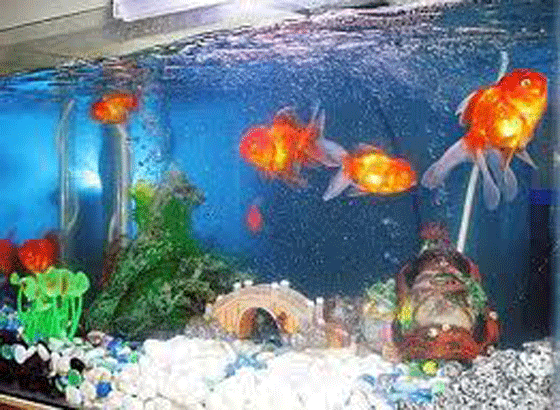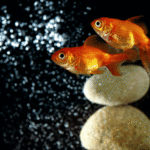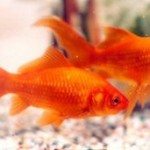Although the basics for setting up a fish tank are simple there are important considerations before buying a tank.
Step 1 is to consider how many goldfish are going to be housed in one tank. Depending on their size, 2 to 3 fish in a medium sized tank is best for a healthy habitat. They need sufficient space to swim and grow.
Once the number of goldfish and size of tank is determined, it’s time to consider what accessories are going to be included in the tank. Some items are necessary to keep the tank running properly, others can be added for decoration.

Table of Contents
How heavy is water?
Water weighs approximately 8 pounds per gallon.
One thing a lot of people seem to forget when placing their tank on a surface is that it will be filled with water. To break it down water weighs approximately 8 pounds per gallon.
At that rate a 10 gallon tank weighs approximately 80 pounds and a 20 gallon tank approximately 160 pounds. So it’s very important that you use the strongest piece of furniture possible. An option is to buy a specially constructed aquarium stand.
The best type of tank
Buy an aquarium that offers the greatest amount of surface area. (Surface area is where the water meets the air.) When it comes to fish tanks you don’t necessarily want to go deep.
Having a deep tank generally means that the water won’t be well aerated and it will be more difficult to make adjustments in the tank and clean the tank because many things on the bottom will be harder to reach. Plus, the fish are not interested in going too deep.
Goldfish would rather swim farther (width-wise) than deeper (length-wise).
Where should a fish tank be positioned?
The best place to setup a tank is near a window, but not in front of it.
When you have your aquarium and stand you’ll need to find the best place to situate them. Some think that the best place for an aquarium is in front of a window. While light is necessary, setting an aquarium in front of a window will cause algae – and lots of it. This leads to cleaning chores of the worst kind and who has time for that?
Water circulation - oxygen and bubbles
About one-fifth of our atmosphere contains oxygen. Therefore we humans have our respiratory needs met. In water things are very different because as little as 1% by volume of water may contain oxygen. This is in well-aerated water. When it comes to goldfish, oxygen is obtained by extraction from the water they inhabit.
It’s the aim of a good aquarist to arrange the aquarium in such a way that the water is never deficient of precious oxygen. A by-product of respiration is carbon dioxide and an excessive amount of this gas in an aquarium is dangerous to goldfish. When water is circulated, the harmful carbon dioxide is carried to the surface and then released into the atmosphere.
The most popular means of providing aeration to an aquarium is by an airstone attached to an airline. The airstone is placed at the rear of the tank so that it can be discreetly hidden. It generates a stream of bubbles which draws water to the surface with them as they rise.
When it comes to the bubbles produced you don’t want too fine a mist, tiny bubbles are best. Keep in mind you don’t want big bubbles racing to the surface. Just a steady stream of medium-sized bubbles that takes its time going upward, giving them a chance to add oxygen to the water.
Airstones are usually made of porous rock attached at the end of an air hose. There are other air-releasers on the market that are generally made of plastic and are weighted at the bottom. You can also purchase some that resemble sunken treasure chests, old- fashioned divers, fallen barrels, etc. Air-releasers and airstones are very important features of any aquarium setup and you should have at least one in a 10 or 20 gallon tank, plus at least two in a 30 gallon tank or larger.
What's the purpose of a filter?
The filter actually has 2 or 3 purposes, depending on what kind you use. It’s responsible for cleansing and purifying the water, circulating water and in most cases it aerates the water.
There are 3 basic types of filters.
- Power filters, which go outside the tank
- Box filters, which go inside the tank, and
- Under gravel filters which are placed in the tank before anything else and cover the bottom of the tank. (This filter uses the gravel as a filtering medium.)
For most beginner aquariums we recommend using a power filter. Power filters are easy to clean and change, and they clean more water faster than any of the other filters. Being able to clean water fast is important because goldfish are not the cleanest of fish and a good filter system is needed.
If you have a tank that’s on the scale of 10 gallons or larger, you should consider using a power filter. Goldfish are too messy and active for a box filter which won’t provide enough air.
An undergravel filter is not ideal because it’s not strong enough to sift out all the debris, which goldfish seem to create in an endless supply.
How does filtration work in fishbowls?
When it comes to housing goldfish, fishbowls are not recommended because of their small surface area. However, if you must use a bowl, make sure that you choose a very small goldfish and choose the largest possible bowl.
An accessory for a bowl that you’ll want to look for is an under gravel/bottom filter. The bases of these filters are round in shape and because of the air used to operate them the water will be better aerated.
Remember, in the case of fishbowls it’s so important to buy the biggest bowl you can find and to make sure it offers as larger surface area as possible. This can’t be over-emphazised.
Lighting
Lighting shouldn’t be neglected because it’s necessary both for illumination and to promote plant growth if you choose to include these in your fish tank. A fish tank light is normally enclosed in a housing unit that sits on top of your cover.
One of the best lights to be used for your tank is fluorescent. Fluorescent lights are cool so they do not unnecessarily heat the water. These lights also tend to spread light more evenly and run on lower wattage than incandescent lights with tungsten filaments.When it comes to incandescent lights they’ll offer good lighting and give any plants in your tank the amount of light they need to thrive.
Whether you choose to use incandescent or fluorescent lights, be sure to choose a natural or white or daylight-grade color light.

Plants – artificial vs living
‘Aquascaping’ means setting up the inside of a fish tank so that it’s pleasing to the fish and the human eye. This includes the placement of plants, rocks, air releases and any wood pieces you have decide to include.
Don’t place too many objects in the tank (over aquascape). You want to leave your goldfish with plenty of room to swim. An area open for swimming is generally called the swimming space.
Goldfish like to hide especially in the plants you provide, but it’s important that they have a place to swim and exert themselves. It’s usually best if the swimming space is left open up front, so you can view the fish when they’re most active.
Goldfish are not especially kind to live plants as they like to munch on them. In order to keep live plants in an aquarium with goldfish it ultimately requires ultimately more care for the plants than for the fish themselves. It can be done, but it requires work and constant attention. You need to think about how much time you want to devote to your tank before you decide on buying live plants.
There are a great number of artificial plants to choose from and many of the better- made ones look like the real thing. The cheaper the artificial plants you purchase, the more plastic they look.
Why buy live plants?
- Live plants are an excellent source of oxygen
- they provide shade and hiding
- they provide egg-laying sites and,
- if handled properly, they provide food for your goldfish.
If you’re a beginner when it comes to goldfish, artificial plants can be a good starting place.
If you choose live plants there are 3 major types of plants: rooted, bunches and floaters.
- Bunches are plants that quickly reproduce and can quickly envelop a tank
- Rooted plants normally grow in numbers then separate from one another
- Floaters are plants that float and whose root system dangles in the water.
Place plants towards the back and sides of the tank so that if they grow large they won’t obscure your vision as they would if you plant them up front. Arrowhead and pond weed plants are best because both are hardy and difficult to kill.
When choosing live plants pick no more than 2 or 3 types of plants. 2 is preferable.
This is a list of live plants that can be bought:
- Rooted Plants-Sagittaria(Arrowhead)
- Vallisneria spiralis
- Echinodorus brevipedicellatus (Amazon Sword Plant)
- Bunched Plants-Anacharis Canadensis (Pondweed)
- Myriophyllum spicatum(Foxtail)
- Microsorum pteropus (Java Fern)
- Floating Plants-Eichhornia crassipes(Water Hyacinth)
- Lemma minor(Duckweed)
Note: Floating plants are highly recommended for goldfish, but for outdoor ponds only because they require a lot of sunlight and grow much too large for aquarium use.
Essential Items
- An air pump, filtration system, heater, thermometer, gravel, and some kind of stick or chemical tester to test the ammonia and nitrate levels in the water are some of the items a fish tank needs to ensure the health of the goldfish.
Other items, such as rocks and plastic plants can be purchased to make the tank more decorative and give the goldfish a place to hide. Real aquatic plants are a good choice, but can be added later if desired.
Step by step guide for set up
- Begin setting up the aquarium by finding a spot that will hold the goldfish tank. It will be very heavy when filled with water, so it may be necessary to purchase a stand to hold this weight. The area must also be level.
- Clean the gravel and place the gravel in the bottom of the tank
- Clean any decorative plants or rocks and add them to the goldfish tank at this time as well
- Hook the filtration system, air pump, and heater to the tank, if necessary. Begin adding water to the tank
- As the water fills the goldfish tank, make sure everything stays arranged and the tank is still level. Continue to fill the tank if everything’s in place
- Plug in the filter and other items and make sure they are in working order. Leave the items plugged in
- Add a water treatment
- The temperature should reach 65 degrees to 68 degrees before adding any fish to the new tank. When the temperature remains at a steady level slowly add the goldfish to the water
Check out our recommended products page and review pages if you’re needing items for setting up your tank.
Now you can relax, watch your fish and enjoy caring for them in their new home. You’ll find the next steps on link below. The all important goldfish feeding tips.







